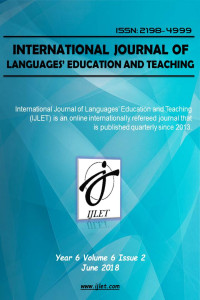Öz
Humor is a fundamental pedogical tool that EFL teachers can utilize in the classroom to maximize their effectiveness. Furthermore, humor in pedagogy is a basic tool that can help teachers to create a motivating atmosphere in class to enhance student learning. For years, educational researchers have tried to investigate humor implementation in the classroom context and humor has been viewed as a classroom learning and teaching catalyzer. In this study, a questionnaire adapted from Morrison (2008), Askildson (2005), Pham (2014) was administered to 110 English preparatory program students at a developing state university located in the Aegean region of Turkey to collect data on their perceptions on teachers’ using humor in the EFL classroom. The interpretation of the findings in this study indicated that the use of humor had positive effects (e.g. creating a more comfortable and conducive learning environment, making students feel more relaxed) in the classroom. All in all, the results showed that humor was important in the EFL classroom and that students indicated a high level of agreement on the positive role of humor in classroom teaching.
Anahtar Kelimeler
Humor Language Learning language Teaching English Preparatory Program
Kaynakça
- Aboudan, R. (2009). Laugh and learn: Humor and learning a second language. International Journal of Arts and Sciences, 3(3), 90-99. Anttila, T. (2008). Lukiolaisten käsityksiä huumorista ja kokemuksia opettajista huumorin käyttäjinä. Joensuun yliopiston kasvatustieteellisiä julkaisuja 126. Joensuu: University of Joensuu.
- Askildson, L. (2005). Effects of humor in the language classroom: Humor as a pedagogical tool in theory and practice. Arizona Working Papers in SLAT, 10, 45-61.
- Baringer, D. K., & McCroskey, J. C. (2000). Immediacy in the classroom: Student immediacy. Communication Education, 49(2), 178-186.
- Bell, N.D. (2005). “Exploring L2 language play as an aid to SLL: A case study of humour in NS-NNS interaction.” Applied Linguistics, 26(2), 192-218.
- Bell, N. D. (2009). Learning about and through humor in the second language classroom. Language Teaching Research, 13(3), 241-258.
Öz
Kaynakça
- Aboudan, R. (2009). Laugh and learn: Humor and learning a second language. International Journal of Arts and Sciences, 3(3), 90-99. Anttila, T. (2008). Lukiolaisten käsityksiä huumorista ja kokemuksia opettajista huumorin käyttäjinä. Joensuun yliopiston kasvatustieteellisiä julkaisuja 126. Joensuu: University of Joensuu.
- Askildson, L. (2005). Effects of humor in the language classroom: Humor as a pedagogical tool in theory and practice. Arizona Working Papers in SLAT, 10, 45-61.
- Baringer, D. K., & McCroskey, J. C. (2000). Immediacy in the classroom: Student immediacy. Communication Education, 49(2), 178-186.
- Bell, N.D. (2005). “Exploring L2 language play as an aid to SLL: A case study of humour in NS-NNS interaction.” Applied Linguistics, 26(2), 192-218.
- Bell, N. D. (2009). Learning about and through humor in the second language classroom. Language Teaching Research, 13(3), 241-258.
Ayrıntılar
| Birincil Dil | İngilizce |
|---|---|
| Konular | İkinci Bir Dil Olarak İngilizce |
| Bölüm | Araştırma Makalesi |
| Yazarlar | |
| Yayımlanma Tarihi | 30 Haziran 2018 |
| Yayımlandığı Sayı | Yıl 2018 Cilt: 6 Sayı: 2 |


